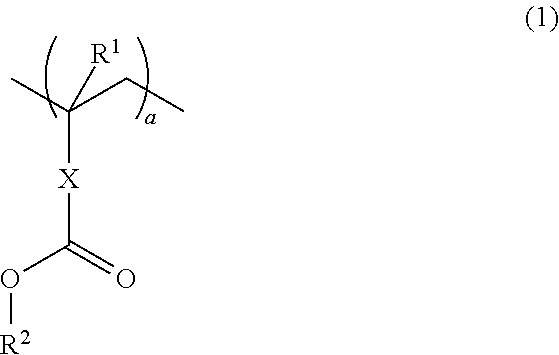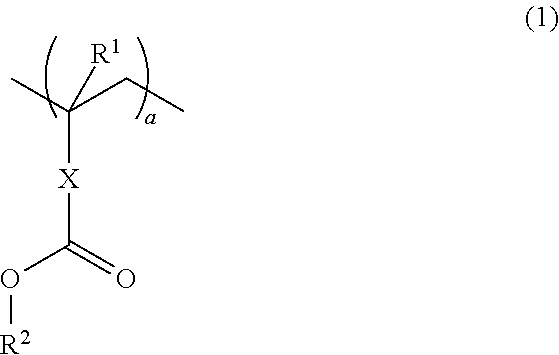Positive resist composition and patterning process
a composition and resist technology, applied in the field of positive resist composition and pattern forming process, can solve the problems of affecting the resolution, the improvement of the step coverage, and the detracting effect of more acid diffusion
- Summary
- Abstract
- Description
- Claims
- Application Information
AI Technical Summary
Benefits of technology
Problems solved by technology
Method used
Image
Examples
synthesis example 1
[0097]Polymers were prepared by selecting and combining suitable monomers, conducting copolymerization reaction in tetrahydrofuran medium, crystallizing from methanol, repeatedly washing with hexane, isolation and drying. The resulting polymers, designated Polymers 1 to 12 and Comparative Polymer 1, had the composition shown below and were suitable for use in resist compositions. The polymer was analyzed for composition by 1H-NMR spectroscopy and for Mw and Mw / Mn by GPC.
synthesis example 2
[0098]Novolak resins were prepared by adding a dihydroxynaphthalene and a co-condensing compound to 37 wt % formalin aqueous solution along with oxalic acid, and stirring at 100° C. for 24 hours. The reaction was followed by dissolving the reaction mixture in 500 ml of methyl isobutyl ketone, thoroughly washing with water to remove the catalyst and metal impurities, evaporating off the solvent under a reduced pressure, and heating at 150° C. and 2 mmHg to remove water and unreacted monomers. The resulting resins, designated Novolak Resins 1 to 18 and Comparative Novolak Resins 1 and 2, had the composition shown below.
[0099]Notably, Novolak Resin 9 was prepared using 2-naphthaldehyde dioxane solution instead of the 37 wt % formalin aqueous solution. Novolak Resin 10 was prepared using 50 wt % 6-hydroxy-2-naphthaldehyde dioxane solution instead of the 37 wt % formalin aqueous solution. Novolak Resin 11 was prepared using 50 wt % 3-furancarboxyaldehyde dioxane solution instead of the 3...
PUM
| Property | Measurement | Unit |
|---|---|---|
| wavelength | aaaaa | aaaaa |
| size | aaaaa | aaaaa |
| size | aaaaa | aaaaa |
Abstract
Description
Claims
Application Information
 Login to View More
Login to View More - R&D
- Intellectual Property
- Life Sciences
- Materials
- Tech Scout
- Unparalleled Data Quality
- Higher Quality Content
- 60% Fewer Hallucinations
Browse by: Latest US Patents, China's latest patents, Technical Efficacy Thesaurus, Application Domain, Technology Topic, Popular Technical Reports.
© 2025 PatSnap. All rights reserved.Legal|Privacy policy|Modern Slavery Act Transparency Statement|Sitemap|About US| Contact US: help@patsnap.com



